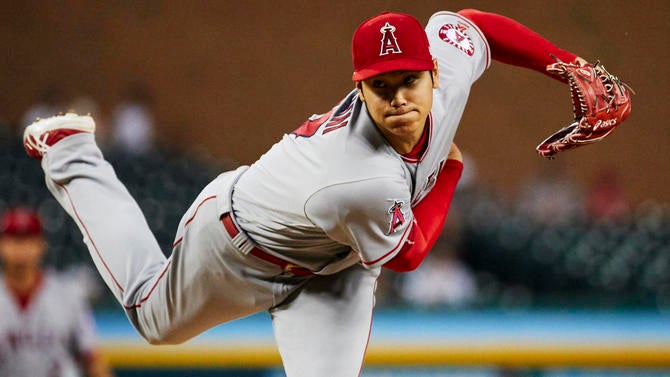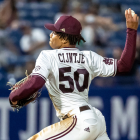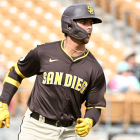With Major League Baseball's season delayed due to the spread of the novel coronavirus, this is an appropriate time to tackle some of the game's biggest questions. For our purposes here, that means addressing a hypothetical posed by our own Fantasy expert Chris Towers, who asked, what would happen if Los Angeles Angels two-way player Shohei Ohtani faced himself?
Ohtani is, in the literal sense, a historic talent. Prior to undergoing Tommy John surgery in 2018, he had accumulated a 3.31 ERA and a 2.86 strikeout-to-walk ratio in 51 innings. Ohtani pitched that well while hitting .285/.361/.564 (151 OPS+) with 22 home runs and 10 stolen bases in 367 plate appearances. His offensive numbers weren't as golden in 2019, but he still hit .286/.343/.505 (123 OPS+) with 18 homers and 12 stolen bases in 425 plate appearances.
Ohtani is expected to return to the mound at some point during the 2020 season (provided there is one), and should continue to be one of the game's most-watched talents. Until then, though, we have a fun little scenario to poke at: Ohtani the pitcher vs. Ohtani the hitter. We'll be attempting to provide an answer through four prisms: what statistical analysis, a proxy matchup, experts, and virtual reality say would happen.
Let's get to it.

Statistical analysis
How can you dig into the numbers on a matchup that has never happened? It's easier than you might think provided you're creative with what you do have -- i.e., tons of data points stemming from Ohtani's performance against other hitters and pitchers.
Because we wanted to be as granular as possible, we focused on Ohtani's hitting numbers against right-handed pitchers. We didn't go the split route with his pitching, seeing as how he's faced fewer than 100 left-handed hitters for his career. With those numbers in hand, we turned to a modified version of log5, an old Bill James invention, to generate an expected slash line.
Here's the log5 formula:
ExAvg = ((BAVG * PAVG) / LgAVG) / ((BAVG * PAVG) / LgAVG + ((1-BAVG)*(1-PAVG)/(1-LgAvg)))
If that looks like a ton of nonsense, well, fair enough. Past research by Dan Fox, who now works for the Pittsburgh Pirates, suggests it gets the job done in a pinch.
Anyway, our log5 calculations say that Ohtani would hit .242/.318/.467 against himself, with 29 home runs over a 600-plate appearance sample. That's right around what Marcell Ozuna (.241/.328/.472) hit last season.
We weren't entirely comfortable with the aforementioned sample-size issues plaguing Ohtani's pitching stats, so we decided to rerun the calculations with some regression worked in. In that hypothetical, Ohtani batted .264/.348/.504. That line puts him above what Brian Anderson did last season (.261/.342/.468) and about 30 points of on-base percentage behind Bryce Harper (.260/.372/.510). Remember: that's Ohtani's performance facing himself and only himself.
It's hard to figure out who "wins" this round: hitter Ohtani, for faring well against one of the game's top pitchers, or pitching Ohtani, for keeping a star hitter under his career norm. We're inclined to say pitcher Ohtani.

Proxy matchup
If you aren't into hypotheticals, then Lord oh Lord are you reading the wrong article. You might find this section more tenable, though, as it centers around a slightly different premise: who has Ohtani faced as a hitter that is most similar to himself as a pitcher, and how did he do?
For the sake of saving time, we used Statcast's similarity score to identify Mike Clevinger as the most similar pitcher to Ohtani. It's not a perfect match on paper -- Ohtani throws a lot of fastballs and splitters against lefties, with some curves mixed in; Clevinger uses his changeup and curveball about equal amounts, giving him more of a three-pronged approach -- but it will do.
Ohtani has faced Clevinger six times in his career: three of those plate appearances coming in 2018, three in 2019. In those, Ohtani went 2 for 5 with a walk. Both of the hits were home runs. Clearly hitter Ohtani wins this round.
Having watched all six battles (you can relive each sequence here), we walked away with a feel for how Clevinger wanted to pitch Ohtani. The two keys were staying away, away, away -- only a handful of the 26 total pitches wound up on the inner half of the plate and inside the zone, and two of those resulted in home runs -- and a big heaping of changeups.
Remember how we noted Clevinger wasn't the ideal match with Ohtani due to his typical approach against left-handed batters? Clevinger took a different route vs. Ohtani. He threw 12 fastballs and 10 changeups, reducing his breaking balls to "show-me" status.
Clevinger's tweaked gameplan didn't work, but it did shed light on what a somewhat similar pitcher -- like, say, Ohtani -- might find in his scouting report if tasked with facing Ohtani.

Experts
With that in mind, we asked a few public-facing scouting experts for their opinions on what would happen if Ohtani had to face himself. Interestingly, each favored Ohtani the pitcher, and thought that his splitter could prove to be the difference.
"Ohtani hit .221 and slugged .286 against offspeed pitches last year," said Kazuto Yamazaki, a contributor at Baseball Prospectus who lives in Japan and has followed Ohtani's career since his Nippon Professional Baseball days. "Since Ohtani the pitcher has an 80[-grade] splitter, in addition to a 70 fastball and a 70 slider, the pitcher would dominate the hitter. If we give them 650 plate appearances (and no talent level change over the time), I think the hitter would bat something like .180/270/.360."
"Ohtani's more of a fastball hitter and I think he'd have severe, severe problems with his own splitter," said Jarrett Seidler, also of Baseball Prospectus. "Hitter Ohtani does absolutely mash righties, but you're not gonna see a lot of righties with a change or split that can neutralize lefties like Pitcher Ohtani, who had reverse splits in 2018."
Ohtani was indeed better against lefties than righties in 2018. As for his splitter, he generated whiffs on more than 55 percent of the swings taken against it. Heck, left-handers didn't record a hit against it, but did nearly notch more strikeouts (17) against it than batted balls (26).
"Ohtani has a pretty keen eye, so the splitter may not be as effective against him," Christopher Crawford of Rotoworld said. "I would guess we'd see some fastballs up-and-in, and if he can get ahead in the count, maybe that nasty split becomes more relevant.
"As good as Ohtani is as a hitter, he's even better on the mound, so I'd give the hurling version the advantage."

Virtual reality
There were moments during our research when we wanted to send some virtual reality gear to Ohtani and request that he face himself over and over again, all to provide us with a satisfying answer. We didn't do that, but we still have some idea of how Ohtani would fare against his digital counterpart thanks to a segment on a Japanese television show from 2016.
Take a look:
Not only did Ohtani swing and miss a lot, but he struggled to keep anything fair. The game concluded that Ohtani's hitting performance would be worth, oh, about $5 a year.
It's a small sample, and it seems likely that Ohtani's woes were owed in part to his unfamiliarity with the VR setup. Nonetheless, we have no choice but to give the nod again to Ohtani's pitching.
So, there you go: if Ohtani were to face himself, he would win -- or his right arm would, anyway.


















